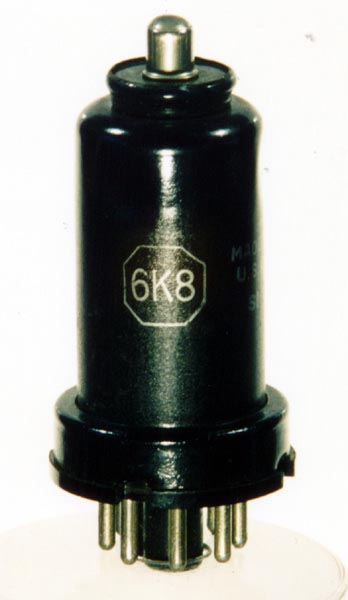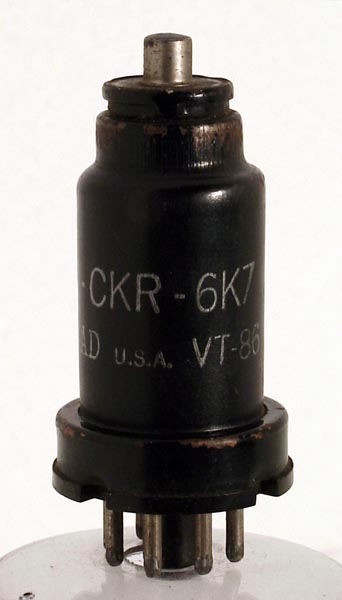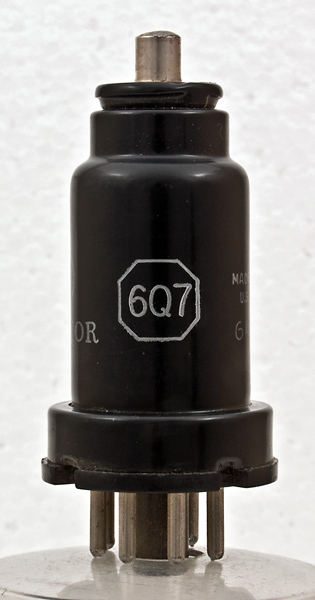|
  
One of the reflections of the Radiolympia show in 1935 was that the Superhet no longer needed seven valves now that multi-electrode valves were being introduced.
From their introduction in the mid 1930s until the end of valve domestic radio the 6K7, 6K8 and 6Q7 set of valves defined the international 'standard' low-cost superhet. Originally developed by RCA as metal Octal types they progressed through -G, -GT, -GT/G and GTY versions, and were in turn re-issued (with different type numbers) as Loctals, squeezed onto B7G (the 6K8 on B7G was very tight), and finally re-expanded into B9A format. Of course, these valves were marketed under a wide variety of manufacturers' own type numbers but the ratings and characteristics remained the same.
The three types comprise a triode-hexode frequency changer (6K8), a vari-μ IF pentode (6K7) and a double-diode triode (6Q7). Of these, the 6K8 gave the most trouble in development and was preceded by a string of less satisfactory Octal types, going right back to the 6A8 which was a pentagrid converter (heptode). However, the 6K8 represents the definitive, final design for a frequency converter having sufficient oscillator stability for all-wave use, good 'pulling' and 'pushing' characteristics, a wide but smooth vari-mu characteristic, and a heater (and heater-cathode rating) which made it equally suitable for AC, DC or 'universal' sets, or for car radios. See also Two New Converter Valves from 1938.
The exhibit 6K8 contains a diagram of the elegant construction of the mixer as a single integrated system. In using, in effect, a double sided triode with the mixer on one side the oscillator injects to g1 and thus the signal goes to g3. In other triode hexode designs such as the Cossor OM10 et al the two sections were separate and the oscillator grid connects to the g3 of the mixer. Although sensibly equivalent types some differences exist in practice between the 6K8 and ECH35 types of design.
Peter Eijlander (PA0PJE) comments: ... had troubles with the main oscillator's stability (mainly chirp on the transmitted signal) using a 6K8G. To my surprise, replacing it with a VR99A (ECH35) almost completely solved that problem. The only reason I can find is the reversal of the interconnected grids in the two valves.
The three valve types being discussed include neither an audio output valve nor a rectifier. The reason for this is that choice of the latter valve types would depend on the type of power supply available. Output valves and rectifiers need more heater power than the universal 6.3V, 0.3A rating so, for example, AC sets with mains transformers could use a type 6V6 beam tetrode and a 5Z4 rectifier delivering 300V. A transformerless set designed to run from 117V would need a 25L6 in order to provide good volume from only 110V of HT, perhaps rectified by a 25Z4. More powerful sets would need larger valves (or push-pull) and a proportionately larger rectifier.
However, the 'Magic Three' types (6K8, 6K7 and 6Q7) between them could and did meet all reasonable requirements in almost any type of radio except battery portables and (much later) FM. The only real direction for improvement was miniaturisation. If you check the valve line-up of any 'ordinary' 1940s, 1950s or 1960s valve mains radio you will almost certainly find these three types in the first three positions, though possibly fitted with a different base cap and probably masquerading under a different type number.
Reni Morris K6XW comments that he has a Howard 430 receiver that utilizes the 'magic three' valves. It was a minimal receiver and not a very good performer. Designed for receiving strong local signals such sets lacked HF amplification before the mixer.
|